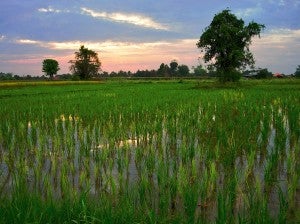Last time you went to the grocery store, did you notice that your pineapple was from Costa Rica, your pears from Argentina, your edamame from China, your salmon from Scotland, and your rice from Thailand?
To address the true environmental impacts of agriculture, we’ll need to think beyond our borders. And to alleviate environmental impacts in countries around the globe, we need to first understand the context of farming in these places.
I asked Dick Wittman, who manages a 19,000-acre dry land crop, range cattle and timber operation in northern Idaho and runs a farm consulting business, to tell me what he and his wife learned about farming and environmental challenges on their recent trip to Thailand.
Why were you in Thailand?
Our daughter Cori, who is a partner in our family farm, started a nonprofit called Breakthrough (affiliated with Servantworks) to help teens in rural Thailand find educational and economic opportunities in their communities – thereby reducing the incentive to get involved in black market activities. She has been in Thailand for five years, and is making a huge difference in people’s lives. Her program is based in an agrarian village in the Chiang Mai region of Thailand. On this trip we helped with a farm construction project– and of course, we also went to just visit our daughter.
What was the farm construction project you helped with?
We built a chicken coop. In this village, chickens naturally run far and wide. They use lots of eggs in their cooking, so the Breakthrough group decided to build a facility to enclose the “herd,” keep predators out, and provide a means to produce eggs for consumption and sale to others. The facility we built is the only one in the region. Here in the U.S., we take for granted how small-scale and simple infrastructure can translate to huge time savings for farmers. With the chicken house, villagers now have more time to spend on other farm projects.

Credit: Flickr user MVX
Can you tell me more about farming in the Chiang Mai region?
Subsistence farming is the norm here – with very small plots where they grow sugarcane, rice, and cassava. They rely heavily on seasonal rains. Historically, the monsoons would come and recharge local ponds where fish would grow, providing another source of food. Past government programs have created water storage ponds for villagers to pump water into the fields. But currently they are experiencing drought conditions—this resulted in only half a normal crop this past year.
What are some of the other environmental challenges in the region?
Many farmers burn at will – causing huge air pollution problems. They burn to clean up forest areas, they burn rice paddies so that it’s easier to plant the next crop, and they burn garbage like plastics, since there isn’t a functioning trash or recycling system in place. At times, the air is almost unbreathable. In U.S. agriculture, we have limits on burning. Another thing we take for granted.
We have made such great strides here in the U.S. on nutrient management, no till, and rotating crops to maximize soil health. In the Chiang Mai region, soil degradation and fertilizer management aren’t on farmers’ radars. Fertilizer is used sparingly, most planting is done by hand, and they have limited access to the market to sell their crops. A high percentage of grain raised is consumed in the households.
Land ownership is also an issue, since paper trails are often nonexistent. Without land ownership, there is limited incentive to improve the quality of soils for the long term.
Does land ownership pose a problem for conservation here in the U.S.?
A huge percentage of land in the U.S. is rented, but as conservation-focused farmers we prefer to work with landlords who share our commitment to environmental stewardship. In the past, landlords used to refuse you as a tenant if you were no-till. But we recently acquired a lease because we are a no-till operation. The landlord saw that method as a more sustainable option. Things are changing – and we’re able to cooperate with owners on land improvements.










